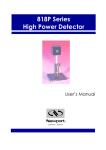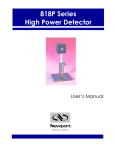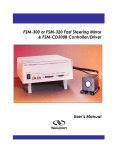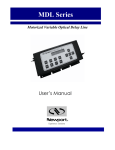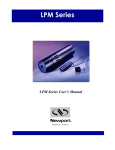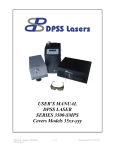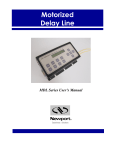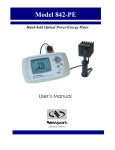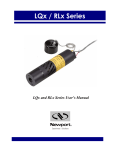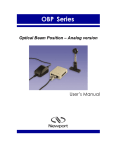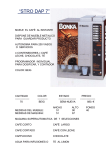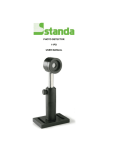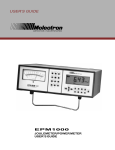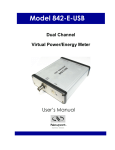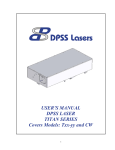Download 818E Series Energy Detector
Transcript
818E Series Energy Detector User’s Manual 1 Warranty Newport Corporation warrants that this product will be free from defects in material and workmanship and will comply with Newport’s published specifications at the time of sale for a period of one year from date of shipment. If found to be defective during the warranty period, the product will either be repaired or replaced at Newport's option. To exercise this warranty, write or call your local Newport office or representative, or contact Newport headquarters in Irvine, California. You will be given prompt assistance and return instructions. Send the product, freight prepaid, to the indicated service facility. Repairs will be made and the instrument returned freight prepaid. Repaired products are warranted for the remainder of the original warranty period or 90 days, whichever is longer. Limitation of Warranty The above warranties do not apply to products which have been repaired or modified without Newport’s written approval, or products subjected to unusual physical, thermal or electrical stress, improper installation, misuse, abuse, accident or negligence in use, storage, humidity (>80%), transportation or handling. This warranty also does not apply to fuses, batteries, or damage from battery leakage. THIS WARRANTY IS IN LIEU OF ALL OTHER WARRANTIES, EXPRESSED OR IMPLIED, INCLUDING ANY IMPLIED WARRANTY OF MERCHANTABILITY OR FITNESS FOR A PARTICULAR USE. NEWPORT CORPORATION SHALL NOT BE LIABLE FOR ANY INDIRECT, SPECIAL, OR CONSEQUENTIAL DAMAGES RESULTING FROM THE PURCHASE OR USE OF ITS PRODUCTS. First printing 2004 © 2004 by Newport Corporation, Irvine, CA. All rights reserved. No part of this manual may be reproduced or copied without the prior written approval of Newport Corporation. This manual has been provided for information only and product specifications are subject to change without notice. Any change will be reflected in future printings. Newport Corporation 1791 Deere Avenue Irvine, CA, 92606 , USA PN 41780-01 Rev I 2 Declaration of Conformity We declare that the accompanying product, the model 818E, identified with the mark, meets the intent of the Electromagnetic Compatibility Directive, 89/336/EEC and Low Voltage Directive 73/23/EEC. Manufacturer’s Name: Manufacturer’s Address: Type of Equipment: Model No.: Year of test & manufacture: Newport Corporation 1791 Deere Avenue Irvine, CA 92606, USA Laser Energy Detector 818E 2002 Standard(s) to which Conformity is declared: Standard Description EN 61326 :1997 Limits and methods of measurement of radio interference characteristics of information technology equipment. Testing and measurements of conducted emission Limits and methods of measurement of radio interference characteristics of information technology equipment. Testing and measurements of radiated emission Electromagnetic compatibility (EMC) – Part 4: Testing and measurements techniques- Section 4.2: Electrostatic discharge. Electromagnetic compatibility (EMC) – Part 4: Testing and measurements techniques- Section 3: Radiated, Radio Frequency immunity. Radiated Electromagnetic field from digital radio telephones- immunity test 900MHz pulsed Electromagnetic compatibility (EMC) – Part 4: Testing and measurements techniques- Section 4: Electrical fast transient/burst immunity. Electromagnetic compatibility (EMC) – Part 4: Testing and measurements techniques- Section 6: Immunity to conducted Radio Frequency. EN 61326 : 1997 EN 61000-4-2:1995 EN 61000-4-3:1996 ENV 50204: 1995 EN 61000-4-4:1995 EN 61000-4-6:1996 Performance Criteria Class A Class A Class B Class A Class A Class B Class A I, the undersigned, hereby declare that the equipment specified above conforms to the above Directive(s) and Standard(s). Alain Danielo VP European Operations Zone Industrielle 45340 Beaune-la-Rolande, France Dan Dunahay Director of Quality Systems 1791 Deere Avenue Irvine, CA USA 3 Technical Support Contacts North America & Asia Newport Corporation Service Dept. 1791 Deere Ave. Irvine, CA 92606 Europe Newport/MICRO-CONTROLE S.A. Zone Industrielle Telephone: (949) 253-1694 45340 Beaune la Rolande, FRANCE Telephone: (800) 222-6440 x31694 Asia Newport Opto-Electronics Technologies 253 Aidu Road, Bld #3, Flr 3, Sec C, Shanghai 200131, China Telephone: (33) 02 38 40 51 56 Telephone: +86-21-5046 2300 Fax: +86-21-5046 2323 Newport Corporation Calling Procedure If there are any defects in material or workmanship or a failure to meet specifications, promptly notify Newport's Returns Department by calling 1-800-222-6440 or by visiting our website at www.newport.com/returns within the warranty period to obtain a Return Material Authorization Number (RMA#). Return the product to Newport Corporation, freight prepaid, clearly marked with the RMA# and we will either repair or replace it at our discretion. Newport is not responsible for damage occurring in transit and is not obligated to accept products returned without an RMA#. E-mail: [email protected] When calling Newport Corporation, please provide the customer care representative with the following information: • • • Your Contact Information Serial number or original order number Description of problem (i.e., hardware or software) To help us diagnose your problem, please note the following conditions: • • • • • Is the system used for manufacturing or research and development? What was the state of the system right before the problem? Have you seen this problem before? If so, how often? Can the system continue to operate with this problem? Or is the system nonoperational? Can you identify anything that was different before this problem occurred? 4 Safety Information Do not use the 818E detector if it looks damaged, or if you suspect that the 818E is not operating properly. Appropriate installation must be done for water-cooled and fan-cooled detectors. Refer to the specific instructions for more information. The user must wait for a while before handling these detectors after power is applied. Surfaces of the detectors get very hot and there is a risk of injury if they are not allowed to cool down. Note: This equipment has been tested and found to comply with the limits for a Class B digital device, pursuant to part 15 of the FCC Rules. These limits are designed to provide reasonable protection against harmful interference in a residential installation. This equipment generates, uses, and can radiate radio frequency energy and, if not installed and used in accordance with the instructions, may cause harmful interference to radio communications. However, there is no guarantee that interference will not occur in a particular installation. If this equipment does cause harmful interference to radio or television reception, which can be determined by turning the equipment off and on, it is suggested to try to correct the interference by taking one or more of the following steps: • • • • Reorient or relocate the receiving antenna. Increase the distance between the equipment and receiver. Connect the equipment to an outlet that is on a different circuit than the receiver. Consult the dealer or an experienced radio/TV technician for help. SYMBOLS The following international symbols are used in this manual: Refer to the manual for specific Warning or Caution information to avoid any damage to the product. 5 Table of Contents Warranty 1 Declaration of Conformity 2 Technical Support Contacts 3 Safety Information 4 Table of Contents 5 1 General Information 7 1.1 Introduction ...................................................................................7 1.2 818E Series DB-15 Connector ......................................................8 2 Specifications 2.1 2.2 2.3 2.4 2.5 2.6 2.7 2.8 9 818E-XX-12-S/-L..........................................................................9 818E-XX-25-S/-L........................................................................10 818E-XX-50-S/-L........................................................................11 818E-0.3-04-S .............................................................................12 818E-XX-12-F.............................................................................13 818E-XX-25-F.............................................................................14 818E-XX-50-F.............................................................................15 818E-0.3-04-F .............................................................................16 3 Operating Instructions 18 3.1 Using with the Newport Optical Power/Energy Meter ...............18 3.2 Using with an Oscilloscope .........................................................20 3.3 Damage to the Optical Absorber Materials .................................21 4 Optional Accessories 23 4.1 818E-DF Attenuator / Diffuser....................................................23 4.2 Other Accessories:.......................................................................24 5 Service Information 25 Appendix A 26 6 Recycling and separation procedure. ....................................................26 5.1 Separation:...................................................................................26 7 1 General Information 1.1 Introduction The Newport 818E Series are high performance and high accuracy pyroelectric energy detectors. Each modular unit is built for durability, compactness and ease of operation. The detectors have square apertures, providing better compatibility with rectangular beam profiles, such as pulsed gas lasers. The modular lowprofile detector heads are designed for ease of installation in tight optical setups. A corner mounting thread permits diagonal mounting of the heads to accommodate longer rectangular beams. 818E Series Energy Detectors exhibit an exceptionally wide dynamic range and are optimized for energy measurements from the UV to far IR. The detectors feature a high intrinsic responsivity and high insensitivity to electromagnetic interference. The 818E optical absorber exhibits high damage thresholds. Some models are equipped with a finned heat sink to extend the power range. The 818E series can be used at even higher energy levels with 818E-DF attenuator / diffuser (see Sections 3.4 and 4.1). 818E-XX-XX-S and –L Series Energy Detectors are designed for user-friendly energy measurement of pulsed lasers when using the Newport Optical Power/Energy Meter. Use with Newport’s legacy 1835-C and 2835-C power/energy meters is enabled when using the 818P-DIN adapter cable (sold separately). Since these detectors require no power source, they can also be used with a 1 MΩ 1 input impedance oscilloscope (or fast chart recorders) when using the 818P-BNC adapter cable (also sold separately). The –S detectors are faster and are designed for shorter pulses, while the –L detectors are for longer pulses and slower repetition rates. The 818E-XX-XX-F Series Fast-Acting Energy Detectors are terminated with a DB15 connector but are not compatible with old 841-PE. The metallic mode is a new addition to the latest Newport Optical Power/Energy Meter. To know if your 841-PE supports the metallic mode see in the “?”/about menu for “Metallic support”. When connecting a 818E-XX-XX-F Series the Optical Power Meter/Energy Meter enters in the metallic mode to ensure proper measurements. The new 842-PE also has improved performance in joulemeter mode that allows 2 additional lower scales. 1918-C, 1928-C, 1936-C/2936-C, and 842-PE support the 818E-XX-XX-F Series. 1 The capacitance of the cable linking the 818E Series to the meter, and the meter input impedance (capacitance and resistance) constitute the total impedance load seen by the detector. The total load capacitance, excluding the integral cable should be less than 30 pfd. 8 Each detector’s individual calibrated sensitivity and spectral correction of this sensitivity are documented in a “Personal Wavelength Correction” certificate, shipped with each unit. All 818E detectors have a 90 cm long coaxial cable, which is terminated in a DB15 male connector. An EEPROM (Electrically Erasable Programmable ReadOnly Memory) inside the DB15 connector shell of the 818E-XX-S and -L is programmed with the calibration sensitivity, the spectral correction factors at different wavelengths and other data relating to that specific detector. This connector permits the Newport Optical Power/Energy Meter to automatically adjust to the characteristics of the particular energy detector being used. Each detector also includes a non-metallic 0.5” diameter post for mounting except 818E-0.3-04-X. An appropriate damage test target is provided, as a safety precaution, with all 818E models. CAUTION To eliminate possible damage, do not carry the detector using the connector cable. 1.2 818E Series DB-15 Connector The DB-15 male connector found at the end of the cable contains an EEPROM (Electrically Erasable Programmable Read-Only Memory) programmed with calibration sensitivity and other data relating to the specific 818E detector in use 2 . Fast set-ups are attained because the Optical Power/Energy Meter automatically adjusts to the characteristics of the detector after reading the EEPROM. The 818E EEPROM can also be read by Newport’s legacy 1835-C and 2835-C meters when using the 818P-DIN adapter cable (sold separately). The DB-15 connector pin-out is as follows: 123456782 Reserved for Meter " " " " " " " " " " " " “+” SIGNAL OUTPUT Reserved for Meter " " " 818E-XX-XX-S and –L models only. 9" " " 10" " " 11" " " 12" " " 13“-“ SIGNAL OUTPUT 14Reserved for Meter 15" " " SHELLCOAX SHIELD / BODY GRN 2 Specifications The following tables list some of the most important specifications for the 818E-Series Energy Detectors. The following specifications are based on a one-year calibration cycle, an operating temperature of 15 to 28 ºC and a relative humidity not exceeding 80%. Storage 5 to 45 ºC and relative humidity not exceeding 80% 2.1 818E-XX-12-S/-L Footnotes Absorber Type 818E-03-12-L 818E-05-12-L Broadband, high damage threshold Wavelength Range 1 0.19 – 20 µm Typical Sensitivity 2, 7 60 V/J 7, 2, 9, 11 ± 3% Calibration Uncertainty Repeatability Max. Pulse Energy @ 1.064 µm @ 266 nm with 818E-DF @ 1.064 µm with 818E-DF @ 266 nm Noise Equivalent Energy (NEJ) < 0.5 % 2, 11 0.85 J 0.7 J 3.9 J 0.81 J 0.7 µJ Min. Measurable Energy (Typ) 2, 4, 11 14 µJ Max. Repetition Rate 2, 5, 11 300 Hz 2, 11 550 µsec 3, 12 (Typ) Typical Rise Time (0-100%) Max. Pulse Width (Typ) 2, 6, 10, 11 400 µsec 2 Max. Energy Density 12 Max. Energy Density with 818E-DF 12, 13 Max. Average Power Detector alone (818E-02-12-S) with optional heatsink (818E-05-12-S) Dimensions (H x W x D) Detector alone (818E-02-12-S) with optional heatsink (818E-05-12-S) Weight Detector alone (818E-02-12-S) with optional heatsink (818E-05-12-S) Aperture Size 818E-XX-12 with 818E-DF Aperture Area 818E-XX-12 with 818E-DF 600 mJ/cm @ 1.064µm, 7ns, 10 Hz 500 mJ/cm2 @ 266nm, 7ns, 10 Hz 16 J/cm2 @1064nm, 7nsec, Single shot 8 J/cm2 @1064nm, 7nsec, 10Hz 6 J/cm2 @532nm, 7nsec, 10Hz 1 J/cm2 @266nm, 7nsec, 10Hz 3 W (7.5 W with 818E-DF) 5 W (12.5 W with 818E-DF) 36 x 36 x 14 mm 36 x 36 x 33 mm 87 g 117 g 12 x 12 mm 9 x 9 mm 1.4 cm2 0.81 cm2 10 2.2 818E-XX-25-S/-L Footnotes Absorber Type 818E-05-25-S 818E-05-25-L 818E-10-25-S 818E-10-25-L Broadband, high damage threshold Wavelength Range 1 0.19 – 20 µm Typical Sensitivity 2, 7 10 V/J 7, 2, 9, 11 Calibration Uncertainty Repeatability Max. Pulse Energy @ 1.064 µm @ 266 nm with 818E-DF @ 1.064 µm with 818E-DF @ 266 nm Noise Equivalent Energy (NEJ) ± 3% < 0.5 % 2, 11 3.75 J 3.1 J 23 J 4.8 J 4 µJ Min. Measurable Energy (Typ) 2, 4, 11 80 µJ Max. Repetition Rate 2, 5, 11 800 Hz 300 Hz 2, 11 200 µsec 550 µsec 2, 6, 10, 11 150 µsec 3, 12 (Typ) Typical Rise Time (0-100%) Max. Pulse Width (Typ) 400 µsec 2 Max. Energy Density 12 Max. Energy Density with 818E-DF 12,13 Max. Average Power Detector alone (818E-05-25-x) with optional heatsink (818E-10-25-x) Dimensions (H x W x D) Detector alone (818E-05-25-x) with optional heatsink (818E-10-25-x) Weight Detector alone (818E-05-25-x) with optional heatsink 818E-10-25-x) Aperture Size 818E-XX-25 818E-DF-25 Aperture Area Size 818E-XX-25 818E-DF-25 600 mJ/cm @ 1.064µm, 7ns, 10 Hz 500 mJ/cm2 @ 266nm, 7ns, 10 Hz 16 J/cm2 @1064nm, 7nsec, Single shot 8 J/cm2 @1064nm, 7nsec, 10Hz 6 J/cm2 @532nm, 7nsec, 10Hz 1 J/cm2 @266nm, 7nsec, 10Hz 5 W (15 W with 818E-DF) 10 W (30 W with 818E-DF) 50 x 50 x 14 mm 50 x 50 x 52.5 mm 120 g 187 g 25 x 25 mm 22 x 22 mm 6.25 cm2 4.84 cm2 11 2.3 818E-XX-50-S/-L Footnotes Absorber Type 818E-10-50-S 818E-10-50-L 818E-20-50-S 818E-20-50-L Broadband, high damage threshold Wavelength Range 1 0.19 – 20 µm Typical Sensitivity 2, 7 3 V/J 7, 2, 9, 11 Calibration Uncertainty Repeatability Max. Pulse Energy @ 1.064 µm @ 266 nm with 818E-DF @ 1.064 µm with 818E-DF @ 266 nm Noise Equivalent Energy (NEJ) ± 3% < 0.5 % 2, 11 15 J 12.5 J 85 J 22 J 15 µJ Min. Measurable Energy (Typ) 2, 4, 11 300 µJ Max. Repetition Rate 2, 5, 11 500 Hz 200 Hz 2, 11 300 µsec 900 µsec 2, 6, 10, 11 225 µsec 3, 12 (Typ) Typical Rise Time (0-100%) Max. Pulse Width (Typ) 675 µsec 2 Max. Energy Density 12 Max. Energy Density with 818E-DF 12,13 Max. Average Power Detector alone (818E-10-50-x) with optional heatsink (818E-20-50-x) Dimensions (H x W x D) Detector alone (818E-10-50-x) with optional heatsink (818E-20-50-x) Weight Detector alone (818E-10-50-x) with optional heatsink (818E-20-50-x) Aperture Size 818E-XX-50 with 818E-DF-50 Aperture Area 818E-XX-50 with 818E-DF-50 600 mJ/cm @ 1.064µm, 7ns, 10 Hz 500 mJ/cm2 @ 266nm, 7ns, 10 Hz 16 J/cm2 @1064nm, 7nsec, Single shot 8 J/cm2 @1064nm, 7nsec, 10Hz 6 J/cm2 @532nm, 7nsec, 10Hz 1 J/cm2 @266nm, 7nsec, 10Hz 10 W (25 W with 818E-DF) 20 W (45 W with 818E-DF) 75 x 75 x 15 mm 75 x 75 x 44 mm 209 g 338 g 50 x 50 mm 47 x 47 mm 25 cm2 22.09 cm2 12 2.4 818E-0.3-04-S Footnotes Absorber Type Very large broadband absorber Wavelength Range Typical Sensitivity Calibration Uncertainty Repeatability Max. Pulse Energy @ 1.064 µm @ 266 nm Noise Equivalent Energy (NEJ) Max. Repetition Rate Typical Rise Time (0-100%) Max. Pulse Width (Typ) 818E-0.3-04-S 1 0.19 – 20 µm 2, 7 150 V/J ± 3% 2, 7, 9, 11 < 0.5 % 2, 11 16 mJ 0.7 mJ 1 µJ 2, 5, 11 1200 Hz 2, 11 200 µsec 3 (Typ) 100 µsec 2, 6, 10, 11 2 Max. Energy Density Max. Average Power Dimensions (H x W x D) mm Weight 13 150 mJ/cm @ 1.064µm, 7ns, 10 Hz 6 mJ/cm2 @ 266nm, 7ns, 10 Hz 0.3 W 20 x 17.5 x 30 20 g Aperture Size 3.7 mm diameter Aperture Area 0.108 cm2 13 2.5 818E-XX-12-F The following tables contain specifications for the 818E-XX-XX-F Series Energy Detectors. Footnotes Optical Absorber 818E-03-12-F 818E-05-12-F Metallic absorber for multi-kHz applications Wavelength Range 1 0.19 – 2.5 µm Typical Sensitivity 2, 7 100 V/J 7, 2, 9, 11 ± 3% Calibration Uncertainty Repeatability Max. Pulse Energy @ 1.064 µm @ 266 nm with 818E-DF @ 1.064 µm with 818E-DF @ 266 nm Noise Equivalent Energy (NEJ) < 0.5 % 0.70 J 0.10 J 1.6 J 0.25 J 3, 12 (Typ) Max. Repetition Rate Typical Rise Time (0-100%) Max. Pulse Width (Typ) 2, 11 0.8 µJ 2, 5, 11 6000 Hz 2, 11 20 µsec 10 µsec 2, 6, 10, 11 2 Max. Energy Density 12 Max. Energy Density with 818E-DF Max. Average Power Detector alone (818E-03-12-F) with optional heatsink (818E-05-12-F) Dimensions (H x W x D) Detector alone (818E-03-12-F) with optional heatsink (818E-05-12-F) Weight Detector alone (818E-03-12-F) with optional heatsink (818E-05-12-F) Aperture Size 818E-XX-12 with 818E-DF Aperture Area 818E-XX-12 with 818E-DF 12, 13 500 mJ/cm @ 1.064µm, 7ns, 10 Hz 70 mJ/cm2 @ 532nm, 7ns, 10 Hz 70 mJ/cm2 @ 266nm, 7ns, 10 Hz 4 J/cm2 @1064nm, 7nsec, Single shot 2 J/cm2 @1064nm, 7nsec, 10Hz 0.35 J/cm2 @532nm, 7nsec, 10Hz 0.3 J/cm2 @266nm, 7nsec, 10Hz 3 W (7.5 W with 818E-DF) 5 W (12.5 W with 818E-DF) 36 x 36 x 14 mm 36 x 36 x 33 mm 87 g 117 g 12 x 12 mm 9 x 9 mm 1.4 cm2 0.81 cm2 14 2.6 818E-XX-25-F Footnotes Absorber Type 818E-05-25-F 818E-10-25-F Metallic absorber for multi-kHz applications Wavelength Range 1 0.19 – 2.5 µm Typical Sensitivity 2, 7 20 V/J 7, 2, 9, 11 ± 3% Calibration Uncertainty Repeatability Max. Pulse Energy @ 1.064 µm @ 266 nm with 818E-DF @ 1.064 µm with 818E-DF @ 266 nm < 0.5 % 3.0 J 0.44 J 10 J 1.45 J 3, 12 2, 11 2 µJ Min. Measurable Energy (Typ) 2, 4, 11 40 µJ Max. Repetition Rate 2, 5, 11 6000 Hz 2, 11 20 µsec Noise Equivalent Energy (NEJ) (Typ) Typical Rise Time (0-100%) Max. Pulse Width (Typ) 2, 6, 10, 11 10 µsec 2 Max. Energy Density 12 Max. Energy Density with 818E-DF 12, 13 Max. Average Power Detector alone (818E-05-25-F) with optional heatsink (818E-10-25-F) Dimensions (H x W x D) Detector alone (818E-05-25-F) with optional heatsink (818E-10-25-F) Weight Detector alone (818E-05-25-F) with optional heatsink (818E-10-25-F) Aperture Size 818E-XX-25 with 818E-DF Aperture Area 818E-XX-25 with 818E-DF 500 mJ/cm @ 1.064µm, 7ns, 10 Hz 70 mJ/cm2 @ 266nm, 7ns, 10 Hz 4 J/cm2 @1064nm, 7nsec, Single shot 2 J/cm2 @1064nm, 7nsec, 10Hz 0.35 J/cm2 @532nm, 7nsec, 10Hz 0.3 J/cm2 @266nm, 7nsec, 10Hz 5 W (15 W with 818E-DF) 10 W (30 W with 818E-DF) 50 x 50 x 14 mm 50 x 50 x 52.5 mm 120 g 187 g 25 x 25 mm 22 x 22 mm 6.25 cm2 4.84 cm2 15 2.7 818E-XX-50-F Footnotes Absorber Type 818E-10-50-F 818E-20-50-F Metallic absorber for multi-kHz applications Wavelength Range 1 0.19 – 2.5 µm Typical Sensitivity 2, 7 4 V/J 7, 2, 9, 11 ± 3% Calibration Uncertainty Repeatability < 0.5 % Max. Pulse Energy @ 1.064 µm @ 266 nm with 818E-DF @ 1.064 µm with 818E-DF @ 266 nm 13 J 1.8 J 44 J 6.5 J 3, 12 2, 11 10 µJ Min. Measurable Energy (Typ) 2, 4, 11 200 µJ Max. Repetition Rate 2, 5, 11 4000 Hz 2, 11 20 µsec Noise Equivalent Energy (NEJ) (Typ) Typical Rise Time (0-100%) Max. Pulse Width (Typ) 2, 6, 10, 11 10 µsec 2 Max. Energy Density 12 Max. Energy Density with 818E-DF 12, 13 Max. Average Power Detector alone (818E-10-50-F) with optional heatsink (818E-20-50-F) Dimensions (H x W x D) Detector alone (818E-10-50-F) with optional heatsink (818E-20-50-F) Weight Detector alone (818E-10-50-F) with optional heatsink (818E-20-50-F) Aperture Size 818E-XX-50 with 818E-DF Aperture Area 818E-XX-50 with 818E-DF 500 mJ/cm @ 1.064µm, 7ns, 10 Hz 70 mJ/cm2 @ 266nm, 7ns, 10 Hz 4 J/cm2 @1064nm, 7nsec, Single shot 2 J/cm2 @1064nm, 7nsec, 10Hz 0.35 J/cm2 @532nm, 7nsec, 10Hz 0.3 J/cm2 @266nm, 7nsec, 10Hz 10 W (25 W with 818E-DF) 20 W (45 W with 818E-DF) 75 x 75 x 15 mm 75 x 75 x 44 mm 209 g 338 g 50 x 50 mm 47 x 47 mm 25 cm2 22.09 cm2 16 2.8 818E-0.3-04-F Footnotes Optical Absorber 818E-0.3-04-F Metallic absorber for multi-kHz applications Wavelength Range 1 0.19 – 2.5 µm Typical Sensitivity 2, 7 200 V/J 2, 7, 9, 11 ± 3% Calibration Uncertainty Repeatability Max. Pulse Energy 1.064 µm 0.266 µm Noise Equivalent Energy (NEJ) Max. Repetition Rate Typical Rise Time (0-100%) Max. Pulse Width (Typ) < 0.5 % (Typ) 3 43 mJ 7.6 mJ 2, 11 1 µJ 2, 5, 11 6000 Hz 2, 11 20 µsec 2, 6, 10, 11 10 µsec 2 Max. Energy Density Max. Average Power Dimensions (H x W x D) mm Weight Aperture Size Aperture Area Size 13 400 mJ/cm @ 1.064µm, 7ns, 10 Hz 70 mJ/cm2 @ 532nm, 7ns, 10 Hz 70 mJ/cm2 @ 266nm, 7ns, 10 Hz 0.3 W 20 x 17.5 x 30 20 g 3.7 mm diameter 0.108 cm2 17 Footnotes for all 818E-Series Specifications 1. 2. 3. 4. 5. 6. 7. 8. 9. 10. 11. 12. 13. See “Personal Wavelength Correction” certificate. Load capacitance must be ≤ 30 pF, excluding the supplied BNC to DB-15 coaxial cable. Assuming 7ns; with a uniform energy distribution; energy applied to full aperture. Increasing the pulse width increases the maximum measurable energy. Based on 20 X NEJ. Actual minimum depends on electrical noise of measurement environment (can be improved with proper signal conditioning). At constant power. To maintain indicated calibration, sensitivity must be de-rated for longer pulses. Calibrated at: 100 mJ, 10 Hz, @1.064 µm, 150 µsec pulse (FWHM), semi-Gaussian beam profile, energy applied to 80% of aperture, loaded into 1 MΩ / 30 pfd. See Calibration Certificate and “Personal Wavelength Correction” data for wavelength specific calibration data from 193 nm to 2.5 µm. Excludes non-linearities. Duration at base of pulse. Divide by 2 for FWHM (Full Width Half Maximum) duration. Loaded into 1 MΩ / 30 pfd. Maximum measurable energy, maximum energy density and maximum average power can be increased by using an optional 818E-DF attenuator / diffuser. Warning: Detector body can reach 60°C at maximum energies. 18 3 Operating Instructions The 818E-XX-XX-F, S and -L Series Energy Detectors are specifically designed to be used with the Newport Optical Power/Energy Meter, although they can be used with other voltage measurement instruments (such as oscilloscopes) using the 818P-BNC adapter cable (see Section 1.1 for details). They can also be used with Newport’s legacy 1835-C and 2835-C power/energy meters using an 818P-DIN adapter cable (sold separately). The 818E-XX-XX-F Series Energy Detectors are are not compatible with the old 841PE. They are compatible with,842-PE, 1918-C, 1928-C, and 1936-C/2936-C. 3.1 Using with the Newport Optical Power/Energy Meter 1. 2. 3. 4. Mount the detector on its optical stand. Connect the DB-15 connector to the Optical Power/Energy Meter. Remove the detector's protective cover, when applicable. Select the proper wavelength on the meter or enter a Correction Factor (see below and the power/energy meter manuals for instructions on this). 5. Put the detector head into the laser beam path (laser beam must be contained within the aperture). CAUTION Do not exceed the maximum levels and densities of energy, peak power and average power, as stated in the specifications tables. The use of a damage test target is strongly recommended (included). 19 WARNING At maximum average powers 818E Series Energy Detectors can reach 60°C and can represent a burn hazard if handled with bare hands. A diffuse back reflection of ~ 30% is present from the energy detector’s optical absorber. NOTE: As with all large aperture pyroelectric devices, these detectors have some position and beam size sensitivity. For the most accurate measurements, the beam should normally be centered on the sensor surface and the beam diameter should ideally be close to that of the original calibration conditions, which is 100% encircled energy (of a semi-Gaussian beam stopped at 1/e2) applied to diameter equal to 80% of the detector aperture. The use of an 818E-DF Attenuator/Diffuser, a divergent lens, a Lambertian diffuser such as opal glass, or any other method of beam spreading, is recommended for this purpose. Please take note that all of the laser light must be directed within the detector aperture and that the transmission loss through the optical component must be known. Setting a Wavelength Correction Factor The Newport Optical Power/Energy Meter will automatically configure itself using the data stored in the EEPROM of the DB-15. This includes the calibration sensitivity and wavelength corrections for 20 different wavelengths. For more precise measurements with an 818E Series Energy Detector at wavelengths other than those already corrected by the “Personal wavelength correction” 3 data programmed into the EEPROM, a correction factor 4 must be entered in the meter to compensate for the change in sensitivity of the detector caused by the change in absorption of the optical absorber at different wavelengths. To correct for the change in absorption, refer to the spectral curve of the “Personal Wavelength Correction” certificate supplied with the energy detector and calculate Cf by taking the ratio between the absorption at the desired wavelength and that at the specified calibration wavelength (usually 1.064µm). Cf = A (λ1) A (@ 1.064 μm ) Here A(λ1) = Absorption of the 818E @ the desired wavelength. A(@ 1.064 μm ) = Absorption of the 818E @ 1.064µm. A sample calculation follows: 3 Refer 4 to the spectral curve of the “Personal Wavelength Correction”certificate supplied with the energy detector. Refer to the Newport Optical Power/energy Meter manuals for instructions. 20 A(λ1) = 92%. A(@ 1.064 μm) = 94% Cf = A(λ1) x 100 A(@ 1.064 μm ) Cf = 92% x 100 = 0.9787 x 100 = 97.87% 94% and is the Correction Factor to be entered in the meter. The data stored in the EEPROM of the DB-15 includes the calibration sensitivity and correction factors for 20 wavelengths without the 818E-DF attenuator installed. When using an 818E Series Energy Detector (at any wavelength) with an 818E-DF attenuator, the user must first calibrate the attenuator. 3.2 Using with an Oscilloscope 1. Mount the detector on its optical stand. 2. Connect the DB-15 into the 818P-BNC adaptor cable (sold separately). 3. Connect BNC into an oscilloscope. NOTE: The required load impedance is 1 MΩ / 30 pfd. 4. Remove the detector's protective cover, when applicable. 5. Put the detector head into the laser beam path (laser beam must be contained within the aperture). 6. Adjust the oscilloscope to trigger on the detector pulse or on the laser sync. signal. 7. Measure the peak to valley voltage generated by the detector. 8. Determine the detector’s sensitivity (in V/J) from the detector identification label or calibration certificate. Select the value given for the wavelength being used. 9. Calculate the optical energy using the following equation: Energy = Vpeak / Calibration sensitivity Example: Vpeak is measured to be 1 Volt. The detector’s calibration sensitivity is 10 V/J. 21 Energy = 1 Volt / 10 V/J = 100 mJ NOTE: Exclude any DC offset from the pulse peak value measurement. This offset is a function of the repetition rate. 3.3 Damage to the Optical Absorber Materials Damage is usually caused by exceeding the specifications in the following areas: - Average Power Density - Peak Pulse Power Density - Single Pulse Energy Density Refer to the 818E Series specifications tables (section 2). This damage can also be caused when using a detector with a contaminated absorber or attenuator surface. The damage threshold figures given in the specifications tables are the point at which a visible alteration of the UV absorber surface 5 occurs. In practice, a slight alteration will not affect the detector response. Consider the detector to be damaged and/or out of calibration when large-scale damage is evident or if the metal electrode beneath the coating is exposed 6 . When using an 818E-DF Attenuator/Diffuser 7 , be aware that damage can occur, thereby damaging the energy detector lying behind it. Consider the detector to be damaged and/or out of calibration if one of the following occurs: • • The front optical component is eroded, or there is sparking at one of the components (front/rear), accompanied by a sharp snapping noise. This phenomenon is related to high single pulse energy density and high peak pulse power density. The optical components are shattered or molten. This phenomenon is related to high average power density. In the case of a TEMoo (Gaussian) beam, the maximum peak power and energy density can be calculated using the following equation: Power (orEnergy ) Density = 5 6 7 2I 0 πW 2 For 818E Series detectors, the use of the appropriate “818E series Test Target " is suggested in order to insure that the laser beam will not damage the detector’s absorber coating. Contact Newport for evaluation, repair, recalibration, or replacement (see the Warranty section, at the beginning of this manual). See optional accessories section. 22 Where I 0 is the total beam power or energy, and W is the beam waist (the 1/e2 point) and π = 3.1416. NOTE: The beam waist for a TEMoo beam is the radius of a circle centered on the beam axis and 8 containing 86% of the beam energy . Example of energy density calculation: Assume I 0 = 1 Joule (total energy) and W = 1 cm. Energy Density = 8 2(1J ) = 0.64 J/cm2 π (1cm) 2 Ref.: SIEGMAN, A.E., An Introduction to Lasers and Masers, p. 313 (Mcgraw-Hill Series in the Fundamentals of Electronic Science). 23 4 Optional Accessories 4.1 818E-DF Attenuator / Diffuser The 818E-DF attenuators increase the energy, energy density, average power and average power density capabilities of the 818E Series Energy Detectors. They are engineered to typically transmit 20 - 35% (@1.064µm) of the incident radiation to the detector in a near Lambertian pattern (very wide diffusion pattern). They are easy to install and remove. Newport does not offer calibration of these attenuators. 818E-DF Attenuator Specifications 818E-DF-12 818E-DF-25 Wavelength Range 190 nm to 2.5 µm Transmission (@ 1.064 µm) 35 % Transmission (@ 266 nm) 30 % Reflectance (@ 1.064 µm) 45 % 818E-DF-50 50 % Reflectance (@ 266 nm) 2 Max. Energy Density 9 Dimensions (L x W x D) mm Aperture Size (L x W) mm For use with 9 16 J/cm @1064nm, 7nsec, Single shot 8 J/cm2 @1064nm, 7nsec, 10Hz 6 J/cm2 @532nm, 7nsec, 10Hz 1 J/cm2 @266nm, 7nsec, 10Hz 30.5 x 41 x 12.5 44 x 55 x 12.5 69 x 80 x 12.5 9x9 22 x 22 47 x 47 818E-XX-12 818E-XX-25 818E-XX-50 Without attenuator, the maximum energy density is limited by the particular detector. See Specification Tables (Section2). 24 4.2 Other Accessories: Contact Newport for a complete list of accessories, their specifications and features. A list of accessories available at the time of this printing includes: • • • 818P-BNC adapter (for connecting 818E Series Detectors to an oscilloscope) 818P-DIN adapter (for connecting 818E Series Detectors to a Newport legacy 1835C or 2835-C power meter) Newport Optical Power/Energy Meter 25 5 Service Information The Model 818E Energy Detectors contain no user serviceable parts. To obtain information regarding factory service, contact Newport Corporation or your Newport representative. Please have the following information available: • Detector model number (818E-XX). • Detector serial number (on rear panel). • Description of the problem. If the detector is to be returned to Newport Corporation, you will be given a Return Number, which you should reference in your shipping documents. Please fill out a copy of the service form, located on the following page, and have the information ready when contacting Newport Corporation. Return the completed service form with the instrument. To obtain warranty service, contact your nearest Newport agent or send the product, with a description of the problem, transportation and insurance prepaid, to the nearest Newport agent. Newport Corporation assumes no responsibility for damage incurred during transit. Newport Corporation will, at its option, repair or replace the defective product free of charge. However, if Newport Corporation determines that the failure is caused by misuse, alterations, accident or abnormal conditions of operation or handling, you will be billed for the repair and the repaired product will be returned to you, transportation prepaid. 26 Appendix A Recycling and separation procedure. This section is used by the recycling center when the monitor reaches its end of life. Breaking the calibration seal or opening the monitor will void the Detector warranty. The complete detector contains 1 Detector with wires or DB-15. 1 instruction manual 1 calibration certificate 5.1 Separation: Paper: Manual and certificate Wires: Cable Detector. Printed circuit board: inside the DB-15, no need to separate (less then 10 cm2). Aluminum: Detector casing. Internal part # 200629 revI 27 Service Form Newport Corporation U.S.A. Office: 800-222-6440 FAX: 949-253-1479 Name _____________________________________ Return Authorization #__________________ __________ (Please obtain RA# prior to return of item) Company ________________________________________________________________________ ____ _______ Address ________________________________ ____________________Date _________________ ___________ Country _______________________ Phone Number ______________________________________ ___________ P.O. Number ___________________ FAX Number Item(s) Being Returned: _________________________________________________________________ _______ ____________________________________________________________________________________ Model # _______________________ ____________ Serial # __________________________ ______ _______ Description _______________________________________________________________________ ___ _______ Reason for return of goods (please list any specific problems): 28 Notes:

































